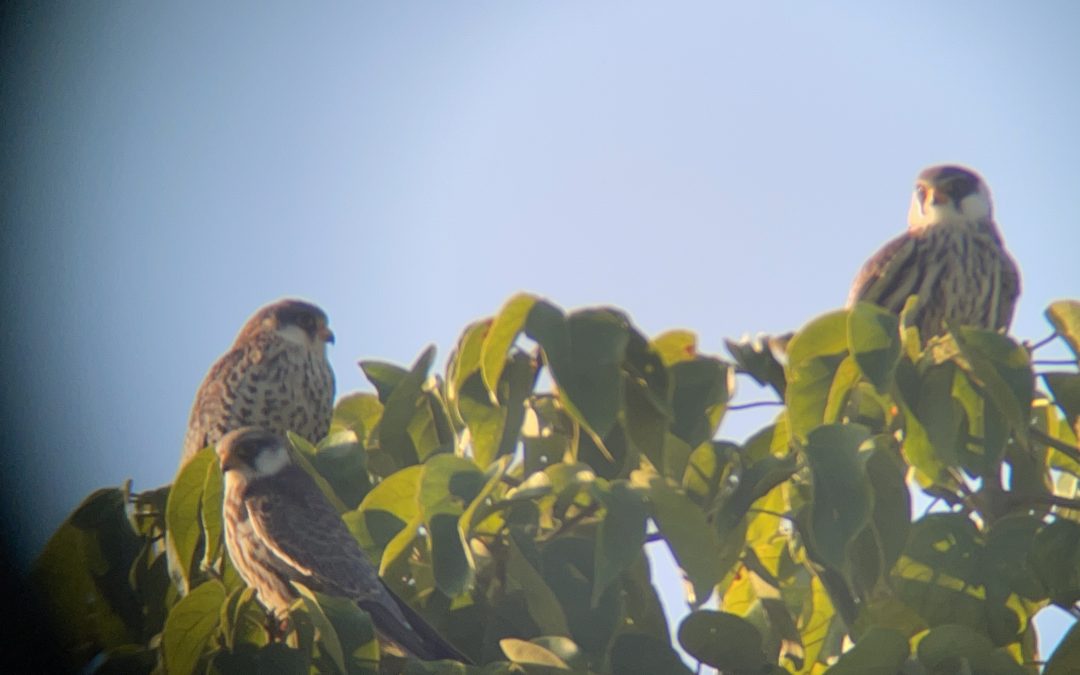This episode is about the magnificent migration of the Amur Falcons, the largest raptor migration in the world.
It is 4:30 AM on a cold day in November. A group of us from Bangalore are driving from Dimapur to Hakhezhe, Nagaland to observe a spectacle like nothing we’ve seen before: the greatest raptor migration on earth. Here is written piece by Scott Weidensaul, who was also a guest in an earlier episode of Bird Podcast on migration. Scott is a migration expert.
The Amur falcon or Falco amurensis breeds between Northern China and Southeastern Siberia. Amurland. Where the Amur river– the tenth longest in the world flows.
Unusually for this year, these falcons have come near Dimapur. They are roosting overnight on the sal and teak trees. Come dawn and they will fly, looking for the large amount of insects– termites, dragonflies, bees and others– that they will catch on the wing.
They are headed for Eastern and Southern Africa where they will winter in warm climes, eating locusts and termites in the fertile red earth of Africa. To get there, they undertake one of the most arduous migrations in the world. First they fly from Siberia to Northeast India. They stockpile food and fat and then fly in one stretch over peninsular India and then over the Indian ocean. Read this article about tracking the Amur falcon in Mint. For this round-trip, they cover anywhere from 22,000 kilometres to 30,000 kilometres, as this article in Bird guides says about satellite tracking these birds– over five long days and nights. Here is a map that shows this migration. Most interesting of all, these birds do what is called an elliptical migration. They don’t take the same route back.
Birds love thermals, which help them soar. But these are largely absent over water. Which means that they have to beat their wings continuously as they fly over the Indian ocean. No wonder they are in a feeding frenzy here in Nagaland. They are also timing their their migration with the massive migration of the dragonflies, which are flying to Africa. A nifty food manouver if you ask me.
About the size of a pigeon, slightly bigger than an American kestrel, the Amur falcon feeds largely on insects but can also fly down to catch small mammals, rodents and reptiles. The males have a gray tuxedo like overcoat and are pale below. The females are dappled: white undersides barred with black, the face seems to have a mustache much like other falcons. Both sexes and the juveniles have orange-red feet and legs.
At exactly 5:15, the first falcon emerges from the trees and within minutes there is more and more. By some estimates there are 50,000 birds in this roosting site. And it is the first year that these birds have come here. Why, we don’t know.
A few years ago, a forest office named Suresh Kumar tagged about 8 amur falcons. They were named after places in the Northeast. One was Manipur and it made a round trip migration of 29,000 kms from Siberia to Somalia and back. Another made a migration of 33,000 kilometres, as the article in Tribune India states. After a week of feeding, these birds will leave Nagaland and fly down peninsular India and over the ocean. Non stop for five days and 13 hours.
The rains in Africa produce swarms of termites, locusts, ants and beetles that provide ample food. Their migration over the Arabian Sea coincides with the timing of the migration of dragonflies (Pantala flavescens) and these are thought to provide food during the most arduous part of their migration route.
The amur falcon conservation story is the topic of many documentaries and news articles, which we have linked to on the episode. One of the key protagonists is journalist and activist Bano Haralu. Here she gives us a glimpse of the story.
Nagaland is a beautiful special place. Most of the state is mountainous with the Naga Hills and Patkai Range passing through it. Bordering Myanmar is Mt. Saramati, the highest peak. 88 percent of the population are Christian and there are 16 tribes. Although we didn’t see the Blyth’s trogopan, Nagaland’s state bird, we saw many other beauteous sights.
But also scroll below for other video links.
This is as much a story about humans as it is about birds. In this early award-winning documentary, the story is told about both the people of Pangti and the Amur Falcons. An article in Mongabay about the film here.
A really informative and brilliant talk by Dr. Suresh Kumar, Wildlife Institute of India. He tagged the Amur Falcons. Why do these birds fly all the way to Africa for instance? What is an elliptical migration? He answers these question.
Sandesh Kadur once told me that a filmmaker he admired was Shekar Dattatri. Well, click below to watch this film by Shekar, who I profiled once for Mint.
A film by Sandesh Kadur and Felis Films based on a poem.
An article by Rohini Nilekani about a sky full of falcons here and pasted below, both as PDF as as text.
“They’ve changed their course, they’ve come closer,” I got an excited call, early in November. This year, the much-delayed, much-awaited migratory Amurfalcons had split up into several groups. Some flew as usual to the far reaches of the Doyang valley and reservoir. But another flock chose to visit Hakhezhe village, not far from Nagaland’s main airport at Dimapur.
What a lucky break. For years, I had been planning the pilgrimage to witness the largest migration of winged raptors on the planet. In the past I had hesitated, daunted by the long, bumpy ride and trek to Pangti, the falcons’ favourite resting stop.
Every year, in late October, lakhs of these majestic little predators emerge from their breeding grounds in Siberia and Mongolia. Together, they soar on westerly winds to their hunting grounds in South Africa, crossing the Arabian Sea along with their prey, the pantala dragonflies, and making a fortnight’s fortuitous stopover in Nagaland.
Once I had confirmation that the falcons had landed propitiously close to somewhat navigable roads, I quickly banded together some friends and our guide, wildlife filmmaker Sandesh Kadur, whose crew had already done the recce. Just hours later, our ragtag team was hurtling from Dimapur to Hakhezhe, where a newly printed welcome banner proclaimed it the village of the Amur falcons.
Three minutes to go, promised our naturalist Sriharsha HK. And as we watched in disbelief, the first black dot in the sky showed up exactly at 4.15 pm, as he had predicted. I thought then of how no one fully understands the biological mechanisms that birds use to navigate; about the theories of vision-based magneto-reception. Then came a second falcon, and a tenth. Within minutes, the sky was darkened by hundreds of thousands of the Amur falcons, swooping down in ever-narrower circles, heading towards the row of teak trees in which they would soon roost. A faint chirping grew into a mellow symphony as the birds signalled to each other, perhaps to avoid mid-air collisions.
After the first overwhelmed oohs and aahs, we could only stand in meditative silence. Necks craning, we waited respectfully in the shade of trees so as not to disturb the birds, who, mercifully, seemed oblivious to us. Within an hour, it was over. The birds had settled precariously in the canopy, soon folding into the night.
In the morning, the pattern was repeated in reverse. We set off at 3 am to make our tryst with the waking falcons, as they snatched the rays of dawn in a dazzling display of golden acrobatics. Now we could train our binoculars better to distinguish the males from the more striated females, the collared juveniles from the parents. In widening, rising circles, they then took off for the day, heading towards the green hills on the horizon in search of food.
Goodbye, we said, our hands on our hearts. It was one of the most unforgettable of experiences. There were many people to thank for this opportunity, first and foremost being the local people. But also, conservationists like Bano Haralu, Rokohebi Kuotsu, Ramki Sreenivasan and Shashank Dalvi, among many others, who have worked for years with the local communities to weave one of the biggest success stories in India’s bird conservation history.
A decade ago, in keeping with long-standing hunting traditions, locals would trap these falcons for food, using large fishing nets strung across treetops. In a remarkably short time, they have begun to see these birds as honoured state guests. There is a hope that the rising opportunities from the growing ecotourism in the area will sustain the positive energy shown by the community to protect the falcons.
It is a fine lesson in the architecture of trade-offs that citizens will have to actively participate in designing, in order to conserve nature and wild beings, not least in order to save ourselves.
Much work still remains ahead. New communities must sign on to become stewards of this vulnerable migrant flock, as the birds shift their routes due to a degradation of their roosting habitats. An eco-tourism based on trusteeship, not extraction, will have to be nurtured. The government could finish tarring half-done roads so that the journey can itself feel like the destination for tourists and birders, across the lovely landscapes of north-east India.
More research is also needed to document the entire voyage of the amazing Amur falcons, across two hemispheres, over plains, mountains and seas. We don’t know since when the falcons have been visiting India, as there are no cultural artefacts and no words for these birds in local languages. Technology could help quantify just how many birds come here (our group estimated 800,000 to 1 million at Hakhezhe, though we have no way of verifying that number). Perhaps research could determine how many such odysseys the average Amur falcon makes in its lifetime (one tagged bird was observed making four trips of approximately 20,000 km each, from its birthplace to its wintering ground and back).
Most of all, many more people need to belong to this tale of mystery, of beauty, of resilience.
It is said that when we are curious, we learn, then we understand, we come to love, and we want to cherish. As I returned home, I felt renewed hope that it is this human journey that may yet turn the tide on climate despair.



Great write up
Hi
Want to visit this year, can you please give me the name of any tourist guide who will give me all support over there.
Thanking you,
Senjuti ,
Kolkata